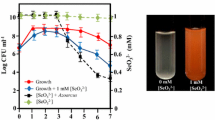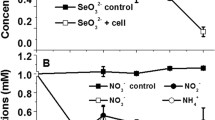Abstract
A bacterium that reduces the soluble and toxic selenite anion to insoluble elemental red selenium (Se0) was isolated from a laboratory bioreactor. Biochemical, morphological, and 16S rRNA gene sequence alignment identified the isolate as a Rhizobium sp. that is related to but is genetically divergent from R. radiobacter (syn. Agrobacterium tumefaciens) or R. rubi (syn. A. rubi). The isolate was capable of denitrification and reduced selenite to Se0 under aerobic and denitrifying conditions. It did not reduce selenate and did not use selenite or selenate as terminal e− donors. Native gel electrophoresis revealed two bands, corresponding to molecular weights of ∼100 and ∼45 kDa, that reduced selenite. Tungsten inhibited in vivo selenite reduction, suggesting that a molybdenum-containing protein is involved in selenite reduction. This organism, or its enzymes or DNA, might be useful in bioreactors designed to remove selenite from water.




Similar content being viewed by others
References
Basaglia M, Toffanin A, Baldan E, Bottegal M, Shapleigh JP, Casella S (2007) Selenite-reducing capacity of the copper-containing nitrite reductase of Rhizobium sullae. FEMS Microbiol Lett 269:124–130
Di Gregorio S, Lampis S, Vallini G (2005) Selenite precipitation by a rhizospheric strain of Stenotrophomonas sp. isolated from the root system of Astragalus bisulcatus: a biotechnological perspective. Environ Int 31:233–241
Doran JW (1982) Microorganisms and the biological cycling of selenium. Adv Microbial Ecol 6:17–32
Garbisu C, Carlson D, Adamkiewicz M, Yee BC, Wong JH, Resto E, Leighton T, Buchanan BB (1999) Morphological and biochemical responses of Bacillus subtilis to selenite stress. Biofactor 10:311–9
Ganther HE, OA Levander CA Sauman (1966) Dietary control of selenium volatilization in the rat. J Nutr 88:55–60
Greenberg AE, Clesceri LS, Eaton AD (eds) (1992) Standard methods for the examination of water and wastewater, 18th ed. American Public Health Association, American Water Works Association and Water Environmental Federation, Washington, DC, pp 82–93
Hunter WJ (2006) Removing selenate from groundwater with a vegetable oil-based biobarrier. Curr Microbiol 53:244–248
Hunter WJ (2007) An Azospira oryzae (syn Dechlorosoma suillum) Strain that reduces selenate and selenite to elemental red selenium. Curr Microbiol 54:376–381
Hunter WJ, Follett RF, Cary JW (1997) Use of vegetable oil to stimulate denitrification and remove nitrate from flowing water. Trans Am Soc Agric Eng 40:345–353
Hunter WJ, Kuykendall LD (2004) Determination of dimethylselenide and dimethyldiselenide by gas chromatography photoionization detection. J Chrom A 1038:295–297
Hunter WJ, Kuykendall LD (2006) Identification and characterization of an Aeromonas salmonicida (syn Haemophilus piscium) strain that reduces selenite to elemental red selenium. Curr Microbiol 52:305–309
Karlson U, Frankenberger WT Jr (1988) Determination of gaseous selenium-75 evolved from soil. Soil Sci Soc Am J 52:678–681
Kessi J, Ramuz M, Wehrli E, Spycher M, Bachofen R (1999) Reduction of selenite and detoxification of elemental selenium by the phototrophic bacterium Rhodospirillum rubrum Appl Environ Microbiol 65:4734–4740
Lawson S, Macy JM (1995) Bioremediation of selenite in oil refinery wastewater. Appl Microbiol Biotechnol 43:762–765
McCready RGL, Campbell JN, Payne JI (1966) Selenite reduction by Salmonella heidelberg. Can J Microbiol 12:703–714
Mokrasch LC, McGilvery RW (1956) Purification and properties of fructose-1,6-diphosphatase. J Biol Chem 221:909–917
Plotnikov VI (1958) Coprecipitation of small quantities of selenium with ferric hydroxide. Zh Neog Klim 3:1761–1766
Rosenberg B, Van Camp L, Kricas T (1965) Inhibition of cell division in Escherichia coli by electrolysis products from a platinum electrode. Nature 205:698–699
Roux M, Sarret G, Pignot-Paintrand I, Fontecave M, Coves J (2001) Mobilization of Selenite by Ralstonia metallidurans CH34 Appl Environ Microbiol 67:769–773
Schmitz RA, Albracht SPJ, Thauer RK (1992) Properties of the tungsten-substituted molybdenum formylmethanofuran dehydrogenase from Methanobacterium wolfei FEBS Lett 309:78–81
Tiedje JM (1982) Denitrification. In AL Page, RH Miller H, DR Keeney (eds) Methods of soil analysis, part 2. Chemical and microbiological properties. American Soil Association-Soil Science Society of America, Madison, WI Pages 1011–1026
Van Fleet-Stalder, Chasteen TG, Pickering IJ, George GN, Prince RC (2000) Fate of selenate and selenite metabolized by Rhodobacter sphaeroides. Appl Environ Microbiol 66:4849–4853
Whanger PD (2004) Selenium and its relation ship to cancer: an update. Br J Nutr 91:11–28
Zieve R, Ansell PJ, Young TWK, Peterson PJ (1985) Selenium volatilization by Mortierella species. Trans Br Mycol Sot 84:177–179
Acknowledgments
The author thanks Robin Montenieri and Kimberly LaCroix for their expert technical assistance. Manufacturer and product brand names are given for the reader’s convenience and do not reflect endorsement by the US government. This article was the work of US government employees engaged in official duties and is exempt from copyright.
Author information
Authors and Affiliations
Corresponding author
Rights and permissions
About this article
Cite this article
Hunter, W.J., Kuykendall, L.D. Reduction of Selenite to Elemental Red Selenium by Rhizobium sp. Strain B1. Curr Microbiol 55, 344–349 (2007). https://doi.org/10.1007/s00284-007-0202-2
Received:
Accepted:
Published:
Issue Date:
DOI: https://doi.org/10.1007/s00284-007-0202-2




